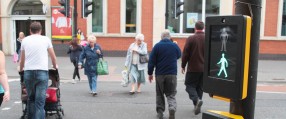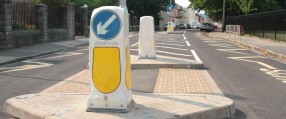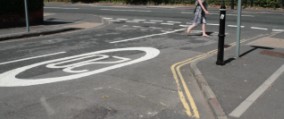Zebra Crossing

Zebra crossings help pedestrians cross from one side of the road to the other. They have white strips painted onto the road in the crossing area, with flashing yellow lights at both sides of the road on black and white striped poles. The kerbs are dropped at both ends of the crossing, usually with tactile paving where the pavement slopes towards the road. Vehicle users can see zigzag lines on the approach to the crossing, and in Bristol this is often with a buff coloured road surface.
Vehicle users are required to stop when they see a pedestrian waiting at the edge of a zebra crossing to allow them to cross the road.
Disadvantages
- If a pedestrian crossing the road is expecting a driver to stop, but they fail to do so, there will be a collision. Many pedestrians wait for cars to stop before they walk into the road
- Sometimes, drivers do not stop when they see a pedestrian waiting at the side of the road
- Blind or partially blind people find zebra crossings harder to use than traffic light crossings
- A zebra crossing which includes a hump or narrowing of the road will require water drainage works, which could be very costly
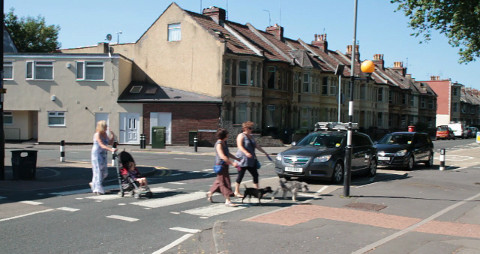
Restrictions
- Zebra crossings must be installed in locations where vehicle users have good visibility of waiting pedestrians. There must be no obstacles (e.g. trees) on the pavement to block the view of pedestrians. The location should not have tight corners or steep hills.
- Can't be installed within 5 meters of a junction or roundabout
- The pavement must be wide enough to make it clear to motor vehicle drivers that pedestrians are waiting at the edge of the road to cross
There's also some general restrictions to note for all schemes
Advantages
- Pedestrians should only have to wait for a very short period of time to cross the road. The first car to see the pedestrian that can stop safely should stop and let the pedestrian cross.
- Typically half the price of a traffic light (puffin) crossing
- Can look more attractive than a traffic light crossing, which could be too obtrusive on smaller streets with narrow pavements
- Low maintenance cost
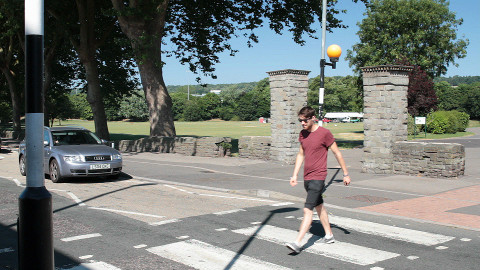
Effectiveness
Usability
Compared to locations without crossings, pedestrians are able to cross the road more quickly with Zebra crossings. On busy roads, with a continuous vehicle traffic flow, Zebra crossings could allow crossing when it would be nearly impossible. Children find zebra crossings particularly beneficial because they find it difficult to judge the speed of traffic when crossing on their own without crossing facilities. The elderly also benefit more from zebra crossings because without a crossing the road might require them to move very quickly to cross, and this may be difficult for them.
Compared to locations where there was no crossing, new zebra crossings have a very positive impact on pedestrian's feelings about crossing the road. Pedestrians are more confident, and feel safer when crossing the road.
Safety
Zebra crossings do not introduce any additional danger to the road environment.
It is difficult to compare Zebra crossings to other crossing designs because there is less research.
In comparison to Puffin crossings, it is most likely that Zebra crossings are very similar in safety, or zebra crossings are only marginally less safe.
If many pedestrians are already crossing at a certain point on a road (the ‘desire line'), it is likely a zebra crossing will not increase or decrease accidents.
Zebra crossings over three or more lanes of traffic will increase collisions. This may be because at roads with two lanes in the same direction, pedestrians can be invisible to motorists in the outside lane when a car on the inside lane is stopping at the zebra crossing.
Advanced information
Usability
Findings on the usability of zebra crossings are based on a study with both observational and opinion survey components (Havard & Willis, 2012). The study only examined a single zebra crossing, however the methodology was strong. On average, pedestrian wait at the curb to start crossing the road was 1.34 seconds without the crossing, falling to 0.22 seconds with the crossing. Pedestrian walking speeds significantly reduced on the crossing, falling from 1.56 to 1.35 meters per second after the crossings was installed. Before the zebra crossing was installed, 34% of people reported feeling safe at the crossing location, rising to 76% after. Similarly, 76% of respondents said they were more confident crossing the road after the zebra crossings was installed compared to before it.
Safety
Comparisons between Zebra and Puffin crossings are based on a relatively weak study from the London Road Safety Unit (2006). This study examined only 6 sites, however the study design was strong within this constraint. Results were an 8% reduction in pedestrian accidents when Zebra crossings were converted to Puffin crossings, however this figure was not statistically significant because there were too few incidents in the study period.
Statements on pedestrian safety effects when there is already a desire line is based on an extremely robust study from the United States. This study compared sites with dropped curbs to sites with a marked crosswalk. The study can only carry limited weight to the conclusion above because assumptions were made. It was assumed that dropped curbs marked a desire line within the street, and also assumed American style cross walks compare well to zebra crossings, as they both require vehicle users to give way. The study found there was no difference in safety on two lane roads before and after a marked cross walk existed, however there was a 4.2 to 4.89 times increased crash risk where there were more than 12,000 motor vehicles a day.
References
Havard, C. & Willis, A (2012). Effects of installing a marked crosswalk on road crossing behaviour and perceptions of the environment. Transportation Research Part F 15 pp. 249 - 260.
Webster, N. (2006) The effect of newly installed Puffin crossings on collisions. London Road Safety Unit, London, UK.
Zegeer, C., Stewart, R., Huang, H., Lagerwey, P. (2001) Safety Effects of Marked Versus Unmarked Crosswalks at Uncontrolled Locations: Analysis of Pedestrian Crashes in 30 Cities. Transportation Research Record 1773 pp. 56 - 68.
